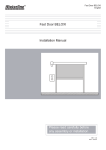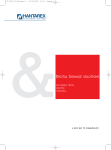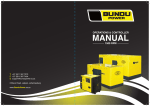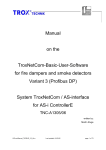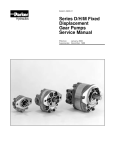Download EYS Screw Press Separator User`s Manual
Transcript
EYS SEPARATOR – EYS 01 G USER MANUAL for EYS SCREW-PRESS SEPARATOR MODEL – EYS 01 G User Manual for EYS 01G Screw-Press Separator EYS SEPARATOR – EYS 01 G Table of Contents Page 1. Introduction 2 2. General Safety Instructions 3 3. Installation 5 4. Start-up and Operation 5 5. Regular Shut Down 7 6. Shut Down for Extended Periods 7 7. Disassembly - Assembly 7 8. Maintenance 8 9. Troubleshooting 9 10. Technical Specifications 10 User Manual for EYS 01 G Manure Separator 1 EYS SEPARATOR – EYS 01 G 1 INTRODUCTION Congratulations on your purchase of the EYS Screw-Press Separator! We are glad that you chose EYS separator for your solid-liquid separation solutions and are confident that you will be more than satisfied with your purchase. This manual is intended to provide basic information about the operation of the EYS Separator, and to point out to main areas of consideration while operating and maintaining the machine. Please read this manual carefully before operating the machinery, and keep it in an easily accessible place for future reference. If any of your questions or concerns are not covered in this manual, please contact the respective dealer who had installed the machinery. Your dealer’s contact information is: If you are not able to reach your dealer and in need of immediate support, then please refer to EYS support contact information provided at the end of this manual. Apart from providing technical and operational instructions, this manual also includes certain safety warnings that must be followed by the user. The safety instructions and warnings listed in this manual are by no means a complete list of all safety concerns associated with operating the machine. Users must apply common sense and abide by the general safety guidelines that govern operating of machinery. Following is a list of icons that are used throughout this manual: Attention! Flammable High Voltage User Manual for EYS 01 G Manure Separator Moving Parts 2 EYS SEPARATOR – EYS 01 G 2 GENERAL SAFETY INSTRUCTIONS FOR “EYS 01 G” Check the operational safety of the machine before every start-up 1. 2. 3. 4. 5. 6. 7. 8. Common and widely accepted general safety precautions must be taken when operating the machinery. The safety highlights in this manual are The warning and instruction signs affixed to the machine must be followed for a safe operation. Do not remove any of these signs for any reason. Do not operate the machine unless all guards and safety devices have been completely mounted and are in their proper operational position. Familiarize yourself with all components and controls of the machine before starting operation. The operator(s) should not wear loose clothing that can be stuck between moving parts. When handling slurry always keep in mind that the gasses produced can be highly toxic and explosive when combined with oxygen. Therefore, open fires, sparks and smoking must be avoided around the operation. Ensure that there is sufficient ventilation when handling the slurry. Keep the machine clean to avoid fire hazards. Maintenance 1. 2. 3. 4. 5. 3 2.1. Check all bolts and nuts regularly and tighten them as necessary. If maintenance service needs to be performed on the machine when it is elevated, always secure the unit using sufficient and secure supports. Dispose any oil, grease and filters according to local laws and regulations. Always turn off power before working on the electric system. Spare parts must meet manufacturer’s minimum technical specifications. Major spare parts should be ordered from the manufacturer to ensure quality operation. GENERAL Handling of slurry Remember that slurry generates potentially dangerous gases under certain conditions. These gases (CO2, NH3, H2S, CH4) can cause intoxications and explosions. Make sure there is sufficient ventilation in the operational area when handling the slurry. Keep your hands and any loose clothing away from moving parts while the machine is in operation or while servicing. Pay special attention to the gear mechanism of the mouth piece, which moves while the machine is in operation. 2.2. Intended use The EYS separator separates fluidic slurry (which must be free of foreign objects such as metal parts, stones, pieces of wood or cloth) into its solid and liquid fractions. The EYS separator is designed for continuous open air operation within a temperature range of 0°C to 40°C. User Manual for EYS 01 G Manure Separator 3 EYS SEPARATOR – EYS 01 G 3. SEPERATOR INSTALLATION 3.1. Sample Farm Layout (for Manure Separation Applications) 3.2. Scope of delivery The EYS Separator is delivered fully assembled, unless otherwise requested for freight purposes. The net weight of the machine is approximately 580kg. 3.3. Required tools The separator needs to be lifted with appropriate lifting machinery (fork lift truck, tractor with front loader, crane) supported by appropriate belts or chains. Installation, mounting and disassembly require the standard hand tools used by mechanics and electricians. 3.4. Installation and mounting If the pump feeding the separator is not an EYS pump, its capacity must not be less than 3 35m /h, otherwise the separator would not achieve its full performance. In order to keep the frictional pressure losses to a minimum, the pipes should have a minimum diameter of 100mm (4”). User Manual for EYS 01 G Manure Separator 4 EYS SEPARATOR – EYS 01 G 4. PREPARATION FOR START-UP • • • • Check the oil level of gearbox. Add or replace oil if necessary. Check connection and tightness of feeding line between pump and separator; connection and tightness of overflow line; free run-off into collecting tank; connection and tightness of line for runoff of separated slurry. Set motor protection at required rated voltage; check correct direction of rotation following the arrow on the housing and on the motor; shut off the motor again. Take away the weights (minimum locking pressure) Make sure that no coarse foreign objects like metal parts, stones, pieces of wood or cloth can get into the separator. Furthermore, be aware that abrasive substances (for instance high portion of sand) will shorten the lifetime of the machine. 5. START UP In order to achieve satisfactory separation results, it is necessary to agitate the slurry before starting the separation procedure. Incoming material must be in a steady consistency. 5.1 Set-up instructions The firmness of the plug and the dryness of the separated solids at the outlet of the machine are set by changing the position of the weights on the two levers according to the performance requirements. It takes several minutes before changes of settings are realized. So always take your time after a change and proceed only in small steps. Before the first start-up or after a longer idle period, switch on the pump for a moment and flood the separator to avoid running dry matter only. Otherwise permanent damage may occur inside the machine. 5.1.1 Building up of the plug If no plug is built up at the discharge end, make sure the discharge flaps fit closely to the mouthpiece. After switching on the power to the separator, start and operate the pump for about 1 or 2 seconds – just long enough to fill up the feeding line and the separator. Then wait until no liquid manure runs out any more and repeat this procedure. After about five repetitions – depending on the slurry properties – a plug of solid matter will build up, pushing the cover away from the mouthpiece. As an alternative you may make a plug by hand: take some fibrous material like newspaper or dry separated solid manure and stuff it firmly behind the flaps. Then start the pump without further interruption. Depending on the solid matter content of the untreated slurry, the plug may already have the right consistency with the first setting of the weight-loaded levers or it may be too wet or too dry. User Manual for EYS 01 G Manure Separator 5 EYS SEPARATOR – EYS 01 G Before switching the pump to continuous operation after building up the plug and performing an output of about 20cm of solid matter, you may have to re-adjust the basic settings. Otherwise the plug may shoot if it is too wet, or it may stall the separator if it is too dry. 5.1.2 Settings for stabilizing the plug • Plug is too dry Push the weights of the levers front (closer to the gear mechanism) or even remove them completely. If the plug is too dry, it may stall the separator because it cannot be pushed out by the screw due to excessive friction forces. Always adjust the weight locations symmetrically on both arms. • Plug is too wet If the plug is too wet, it may shoot, which means that the plug is going to dissolve and unseparated slurry will escape. To stabilize the plug, move the weights back (away from the gear mechanism) symmetrically. If this does not help, mount one more weight. Depending on the slurry consistency, the above mentioned settings may need to be repeated several times at the start-up of the separator until stable conditions have been reached. These steps are essential in achieving the optimum separator performance. 5.2 Further instructions for trouble-free operation Pay attention that the overflow line does not create suction by by-passing the incoming material directly back to the reservoir, preventing flow of incoming material into the separator. This would result in no output or significantly decreased separation output. The overflow pipe must be free of any obstructions or kinks. Otherwise it may block up or collapse, which would increase the pressure inside the separator too much and eject the plug. Make sure the overflow (by-pass) line is free of any obstacles, and that its discharge end is not submerged into the reservoir. End of the by-pass line should be kept at atmospheric pressure. A vent valve may also need to be mounted on the inlet tee. If the feeding pump capacity is too high, this may also affect the intake into the separator adversely. User Manual for EYS 01 G Manure Separator 6 EYS SEPARATOR – EYS 01 G The incoming flow must be reduced until the overflow pipe is returning less than half of its full discharge capacity. As a guide, the overflow pipe should be full by about 1/3 of its cross section Make sure that the slurry is mixed thoroughly before separation in order to avoid shooting and stopping up of the plug. Important note: do not mix or pump the slurry too often (particularly when the pits are of smaller size). This would change the consistency of the slurry and make it greasy. 6. REGULAR SHUT-DOWN 1. 2. 3. 4. Switch off the feeding pump. Switch off the separator. If the separator is going to stay out of operation for several days, first keep it running for one or two more minutes before switching it off so that the material inside is discharged. Depending on the kind of treated slurry, the separator can be left out of operation for a week or so without having to remove the plug. For longer idle periods remove the plug and clean the separator. Withdraw the cover and clear away the plug by hand. if the separator is going to be used at temperatures below freezing point, be sure to drain completely all inlet and return pipes as well as the separator itself after finishing the separation in order to avoid slurry from freezing inside the machine. 7. SHUT-DOWN FOR EXTENDED PERIODS If your EYS Separator will not be used for a longer time, put it out of operation according to chapter 6 and clean it according to chapter 9; “Disassembly”. Store the machine in a dry place and apply grease on exposed mechanical connections as necessary. 8. DISASSEMBLY – ASSEMBLY 9.1 Disassembly It is necessary to disassemble the separator from time to time for: • • • • Cleaning of screen and screw Replacing screen and screw Removing foreign objects in case of separator blockage Removing dried solid matter which remains sticking to the screw after a long idle period Follow the steps described below to disassemble the machine, referring to the coinciding numbers shown on the pictures: User Manual for EYS 01 G Manure Separator 7 EYS SEPARATOR – EYS 01 G 1. Remove all weights (the three pieces at the end of each arm [1] ), 2. Do not unscrew the bolts which fix the mouth weight system. 3. Unscrew the four mouth-flange bolts and remove the mouthpiece. 4. Do not unscrew the bolts which fix the screen guiding. It has been preset at the factory to give the screen the correct orientation! 5. Unscrew the bolt of screw shaft. 6. Pull out the screen. 7. Pull out the screw shaft. 9.2 Assembly The separator can be re-assembled by following the dismantling instructions in reverse order. Make sure that all moving parts are working free of obstruction and that the screw is turning in the correct direction before mounting the screen (the screw has to turn clockwise when observed from the discharge end). Before mounting the screw, clean thoroughly and grease the fitting surface/axle journal of the screw as well as the bearing. Then tighten the shaft nut. 9. MAINTENANCE Gearbox and motor are delivered ready for operation. They are pre-filled with the appropriate quantity of synthetic oil and are practically maintenance-free for long periods of time. After about 10.000 operating hours or 3 years of operation however, the oil must be changed. If the screen is found to be partially clogged by fibrous material, clean it from both sides with a high pressure power washer or with a hose. In case the screw tips wear out in time, please contact either your dealer or the manufacturer for repairing or replacing the part(s). User Manual for EYS 01 G Manure Separator 8 EYS SEPARATOR – EYS 01 G 10. TROUBLESHOOTING Problem Possible Cause Separator stops by itself Overload Plug too dry Solution Check motor protection circuit for proper setting, if necessary adjust it to maximum value. Foreign object blocks the screw Check separator inlet, remove foreign object; check screw and screen. Solid output too low, plug is too dry Weights too close to the front end of the levers. See setting instructions – 5.1 Increased wear on screw and screen Abrasive components in the slurry (e.g. sand) Let abrasive components settle as much as possible before separation Moisture content of the discharged Different consistency of raw slurry solid matter varies considerably Mix and homogenize slurry thoroughly. Low output of solid and liquid fraction Intake too low Check the pump (direction of rotation) Check the feeding line Possible suction effect from the overflow line, slurry is by-passed directly through the overflow line back to the reservoir rather than being pumped into the separator Mount vent valve/pipe onto inlet tee of separator Screen clogged Disassemble and pull out the screen for cleaning. Screw or screen worn out Check screw diameter, replace the screw if necessary, check screen wear and replace it if required. Screen is worn out only in certain places, wrong setting of screen guiding Check obstruction or dirt accumulation on the screen guide rails. Incorrect direction of the screw rotation Check electrical connections, reverse if necessary Solid matter stuck between screw pitches, co-rotating with screw Pull out and clean the screw Solid matter content in raw slurry is too low. Weights pushed forward too far (not enough pressure). Mix and homogenize the slurry properly. See setting instructions – 5.1 No solid output, minimum liquid discharge Plug is dissolving and liquid runs out of the mouthpiece Reduce intake so that overflow pipe is only half filled at max. Make sure the overflow can run out freely. Solid matter is too fine and has no Use a finer screen fibrous structure User Manual for EYS 01 G Manure Separator 9 EYS SEPARATOR – EYS 01 G 11. TECHNICAL DATA Part Screw, screw-shaft Screen Intake housing Housing shell Feeding line, overflow Discharge Base frame Motor Gearbox Properties Hardened surface 0.3 / 0.5 / 0.75 / 1.0 mm 4” pipe 4” pipe 5.5kW, 380V, 60Hz, 1440rpm PD42, 30 to 35 rpm IP54, User Manual for EYS 01 G Manure Separator Material Stainless steel Stainless steel Carbon steel Carbon steel Carbon steel Carbon steel Carbon steel (varies by country) 10














